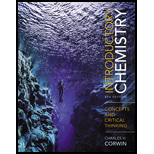
(a)
Interpretation:
Plutonium,
Concept introduction:
An atom is a single entity there is no bonding for an atom alone. A molecule is the combination of two or more atoms of same or different elements bonded together by a covalent bond. A formula unit is the combination of atom of two or more elements bonded together by the ionic bonds.
(b)
Interpretation:
Oxygen,
Concept introduction:
An atom is a single entity there is no bonding for an atom alone. A molecule is the combination of two or more atoms of the same or different elements bonded together by a covalent bond. A formula unit is the combination of the atom of two or more elements bonded together by the ionic bonds.
(c)
Interpretation:
Plutonium(III) oxide,
Concept introduction:
An atom is a single entity there is no bonding for an atom alone. A molecule is the combination of two or more atoms of the same or different elements bonded together by a covalent bond. A formula unit is the combination of an atom of two or more elements bonded together by the ionic bonds.
(d)
Interpretation:
Hydrogen peroxide,
Concept introduction:
An atom is a single entity there is no bonding for an atom alone. A molecule is the combination of two or more atoms of the same or different elements bonded together by a covalent bond. A formula unit is the combination of the atom of two or more elements bonded together by the ionic bonds.
Want to see the full answer?
Check out a sample textbook solution
Chapter 12 Solutions
Introductory Chemistry: Concepts and Critical Thinking Plus MasteringChemistry with eText -- Access Card Package
- Which of the following statements are true regarding a covalent bond between nitrogen and oxygen atoms in a nitric oxide, NO, molecule? (a) Valence electrons are shared between nitrogen and oxygen atoms. (b) Bonding electrons are found only between the bonded atoms. (c) The bond length is greater than the sum of the two atomic radii. (d) Energy is required to break a covalent bond.arrow_forwardWrite the chemical formulas for the following compounds:(a) Silver cyanide(b) Calcium hypochlorite(c) Potassium chromate(d) Gallium oxide(e) Potassium superoxide(f) Barium hydrogen carbonatearrow_forwardWhat are the chemical formulas for ( a ) disulfur dioxide and ( b ) iodine pentafluoride ?arrow_forward
- The atomic number of sulfur is 16. Sulfur combines withhydrogen by covalent bonding to form a compound, hydrogensulfide. Based on the number of valence electrons in a sulfuratom, predict the molecular formula of the compound.(A) HS(B) HS2(C) H2S(D) H4Sarrow_forwardName the following binary ionic compounds. (a) MgF2 (b) Bal2 (c) FeCl2arrow_forwardNa+ forms an “ionic bond” (i.e. an electrostatic attraction) with the OCN− ion. (a) Draw the full Lewis structure of the ionic compound. Be sure to show how you have derived this. (The ionic compound as a whole, not just OCN-) (b) Which atom in the OCN− anion is the sodium cation most likely to attract? Explain.arrow_forward
- How many electrons are in the valence shell of each atom? (a) Carbon (b) Nitrogen (c) Chlorine (d) Aluminumarrow_forwardAssume that you encounter the following phrases in your reading. What is the chemical formula for each substance mentioned? (a) Sodium Hydrogen carbonate is used as a deodorant. (b) Calcium hypochlorite is used in some bleaching solutions. (c) Hydrogen cyanide is a very poisonous gas. (d) Magnesium hydroxide is used as a cathartic. (e) Tin (II) fluoride has been used as a fluoride additive in toothpastes. (f) When cadmium sulfide is treated with sulfuric acid, fumes of hydrogen sulfide are given off.arrow_forwardWhich statements are true about electronegativity? (a) Electronegativity increases from left to right in a period of the Periodic Table. (b) Electronegativity increases from top to bottom in a column of the Periodic Table . (c) Hydrogen, the element with the lowest atomic number, has the smallest electronegativity. (d) The higher the atomic number of an element, the greater its electronegativity.arrow_forward
- Which of these elements is most likely to form ions with a2+charge?(a) Li (b) Ca (c) O (d) P (e) Clarrow_forwardA resident expert on electronegativity comes up to visit with you. He makes two claims (seen below) about electronegativity with relation to covalent bonding. Is the expert correct or can you refute him with your knowledge of electronegativity? (a) If a diatomic molecule is made up of atoms X and Y, which have different electronegativities, the molecule must be polar. (b) The farther two atoms are apart in a bond, the larger the dipole moment will be.arrow_forwardWrite the formulas of the following covalent compounds. (Type your answer using the format CO2 for CO2.) (a) silicon tetrachloride(b) carbon tetrachloride(c) dinitrogen tetroxide(d) dinitrogen oxidearrow_forward
 ChemistryChemistryISBN:9781305957404Author:Steven S. Zumdahl, Susan A. Zumdahl, Donald J. DeCostePublisher:Cengage Learning
ChemistryChemistryISBN:9781305957404Author:Steven S. Zumdahl, Susan A. Zumdahl, Donald J. DeCostePublisher:Cengage Learning ChemistryChemistryISBN:9781259911156Author:Raymond Chang Dr., Jason Overby ProfessorPublisher:McGraw-Hill Education
ChemistryChemistryISBN:9781259911156Author:Raymond Chang Dr., Jason Overby ProfessorPublisher:McGraw-Hill Education Principles of Instrumental AnalysisChemistryISBN:9781305577213Author:Douglas A. Skoog, F. James Holler, Stanley R. CrouchPublisher:Cengage Learning
Principles of Instrumental AnalysisChemistryISBN:9781305577213Author:Douglas A. Skoog, F. James Holler, Stanley R. CrouchPublisher:Cengage Learning Organic ChemistryChemistryISBN:9780078021558Author:Janice Gorzynski Smith Dr.Publisher:McGraw-Hill Education
Organic ChemistryChemistryISBN:9780078021558Author:Janice Gorzynski Smith Dr.Publisher:McGraw-Hill Education Chemistry: Principles and ReactionsChemistryISBN:9781305079373Author:William L. Masterton, Cecile N. HurleyPublisher:Cengage Learning
Chemistry: Principles and ReactionsChemistryISBN:9781305079373Author:William L. Masterton, Cecile N. HurleyPublisher:Cengage Learning Elementary Principles of Chemical Processes, Bind...ChemistryISBN:9781118431221Author:Richard M. Felder, Ronald W. Rousseau, Lisa G. BullardPublisher:WILEY
Elementary Principles of Chemical Processes, Bind...ChemistryISBN:9781118431221Author:Richard M. Felder, Ronald W. Rousseau, Lisa G. BullardPublisher:WILEY





